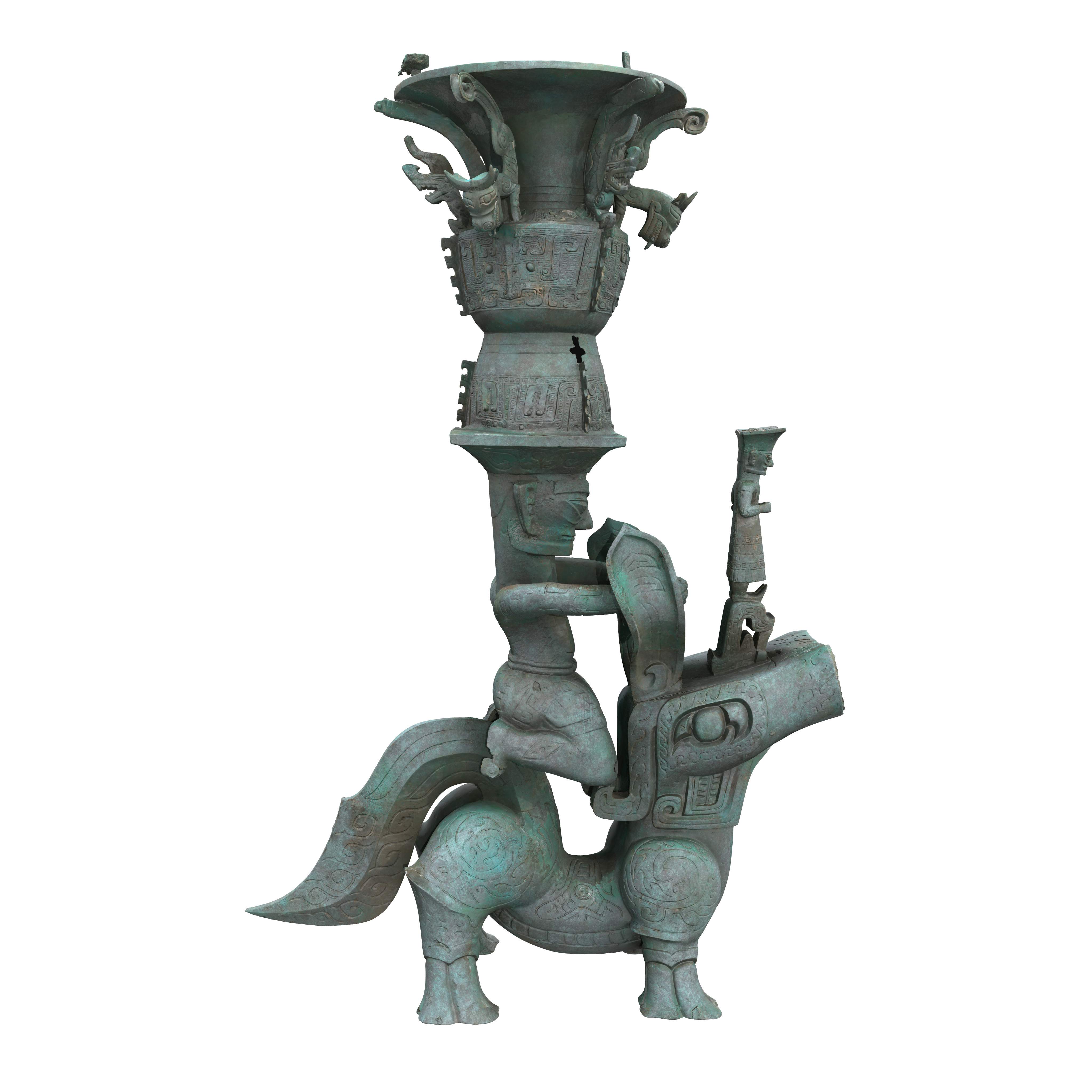Bronze figure riding a beast with zun on top

Bronze figure in riding posture with Zun on top: This piece was excavated from the southern section of Pit No. 3 at Sanxingdui. The artifact consists of two parts: a bronze zun and a kneeling figure. The bronze zun stands on a square flat base, beneath which a kneeling human figure is positioned, with both hands clasped forward. The zun features a square lip, wide mouth, slightly constricted long neck, narrow sloping shoulders, and a straight abdomen that tapers slightly inward near the base. Three raised string patterns encircle the lower part of the neck. The shoulders are adorned with kuilong (mythical dragon) motifs, set against cloud and thunder patterns. Additionally, the shoulders feature two distinctive three-dimensional dragon-shaped decorations. The abdomen and foot of the vessel are embellished with beast face motifs set against a cloud and thunder background, with ridged edges forming interlocking hooks. Three raised string patterns also decorate the upper part of the foot. The foot has been artificially cut, leaving the beast face and ridges incomplete.
The bronze figure has thick eyebrows, large eyes, a prominent nose bridge, wide nostrils, a broad mouth, square jaw, and large ears. It has a long, slender neck and an upright posture, with arms raised and hands clasped. The figure is dressed in a long-sleeved, front-opening tunic with a cloud and thunder pattern, tied around the waist with two belt loops forming a front knot. The figure wears trousers decorated with eye-shaped patterns, and the knees feature small perforations. Visible welding marks indicate where the zun was attached to the figure.
Bronze mythical beast: Unearthed from the northeastern corner of Pit No. 8, this bronze mythical beast stands about 90 cm tall. The artifact consists of a large mythical beast supporting a standing human figure on its head. The beast resembles both a horse and a dog, likely a fantastical hybrid of multiple animals. It has a long snout, wide mouth, and "chen" (臣)-shaped eyes. A pair of long ears extends from the back of its head, with two strands of mane running down its neck. The sturdy limbs stand firmly, each foot featuring four petal-shaped toes. A large tail extends downward from its back. The surface of the beast is adorned with cloud, fire, and scale motifs.
At the center of the mythical beast's head stands a small bronze figurine. The figure's overall posture closely resembles the famous Bronze Grand Statue of Human Figure unearthed from Pit No. 2 at Sanxingdui in 1986. It has a slender physique, protruding eyes, and an upright stance, with both hands in a gripping position. The figure wears a diagonally collared long robe, cloud-patterned shoes, and a double-pointed crown. This artifact features a hidden decorative element: on the front of the beast's horn, there is a cave-like hollow about 2 cm in height, inside which kneels a tiny figure with both feet on the ground and hands in a gripping posture. This intricate detail further highlights the artifact's exquisite craftsmanship. The large standing bronze beast is the largest intact zoomorphic bronze artifact discovered at Sanxingdui to date. With its complex structure and refined craftsmanship, its design reflects the boundless imagination and creativity of the ancient Shu people. It is undoubtedly another world-shocking treasure of the Sanxingdui civilization.
Additionally, a number of newly unearthed important artifacts exhibit unique characteristics.